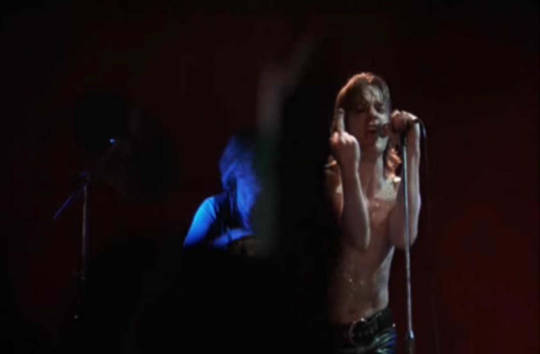Personality Crisis: The Radical Fluidity of Todd Haynes Velvet Goldmine by Judy Berman
By Yasmina Tawil

[This month, Musings pays homage to Produced and Abandoned: The Best Films Youve Never Seen, a review anthology from the National Society of Film Critics that championed studio orphans from the 70s and 80s. In the days before the Internet, young cinephiles like myself relied on reference books and anthologies to lead us to film we might not have discovered otherwise. Released in 1990, Produced and Abandoned was a foundational piece of work, introducing me to such wonders as Cutters Way, Lost in America, High Tide, Choose Me, Housekeeping, and Fat City. (You can find the full list of entries here.) Over the next four weeks, Musings will offer its own selection of tarnished gems, in the hope theyll get a second look. Or, more likely, a first. Scott Tobias, editor.]
Like the glam rockers it gazes upon through the smoke-clouded lens of memory, Velvet Goldmine is most beautiful when it descends into chaos.
Stolen, the way great artists do, from Citizen Kane, the skeleton of Todd Haynes 1998 film is a chain of interlocking reminiscences of Brian Slade (Jonathan Rhys Meyers), a David Bowie-like glam rocker who fakes his own onstage death in the mid-70s. A decade laterin that most dystopic of years, 1984his ex-wife Mandy (Toni Collette) and former manager Cecil (Michael Feast) relate their bitter tales of betrayal to a journalist (Christian Bale) whose assignment has him reluctantly reliving his own teenage sexual awakening under the influence of Brians music. Between the interviews, musical numbers, and onscreen epigrams, theres also a mysterious female narrator who sometimes surfaces, like a teacher reading a subversive storybook, with dreamy exposition that reaches back a century to invoke glams patron saint, Oscar Wilde.
The film climaxes with a propulsive sequence of scenes that are exhilarating precisely because they merge all of these points of view, subjective and omniscient, into one collective fantasy. Brian and his new conquest, the Iggy Pop/Lou Reed composite Curt Wild (Ewan McGregor), ride mini spaceships at a carnival to Reeds Satellite of Love. Two random schoolgirls, their faces obscured, act out a love scene between a Curt doll and a Brian doll. In a posh hotel lobby, Brians entourage, styled like Old Hollywood starlets on the Weimar Germany set of a fin-de-sicle period film, recites pilfered sound bites about art. Then Brian and Curt are kissing on a circus stage, surrounded by old men in suits. They play Brian Enos Babys on Fire as Haynes cuts between the performance, an orgy in their hotel suite, and Bales hapless, young Arthur Stuart masturbating over a newspaper photo of Brian fellating Curts guitar. Stripped of narrationnot to mention narrativethe film seems to be running on its own amorous fumes, its story fragmenting into a heap of glittering images as it hurtles from set piece to set piece.

Visual pleasure aside, its a perfect way of translating into cinematic language the argument that underlies Haynes scriptthat glams revelations about the radical fluidity of human identity go far beyond sex and gender. As the apotheosis of teen pop audiences thirst for outsize personae, fictional characters like Ziggy Stardust (who Velvet Goldmine further fictionalizes as Slades alter ego, Maxwell Demon) melded the symbiotic identities of artist and fan into a single, tantalizing vision of hedonism and transgression. Kids imitated idols they didnt quite recognize as pure manifestations of their own inchoate desires. Musician and fan became each others mirror, and both could become entirely new people simply by changing costumes or names.
But its pretty much impossible to imagine Velvet Goldmines distributor and co-producer, Harvey Weinstein, appreciating this as he watched the film for the first timeor seeing anything in it, really, besides an expensive mess.
Haynes and his loyal producing partner, Killer Films head Christine Vachon, had already been through hell with Velvet Goldmine by the time they delivered a cut to Miramax. Bowie had refused Haynes repeated requests for permission to use six Ziggy-era songs in the film, claiming that he had a glam movie of his own in the works. And in a production diary that appears in her book Shooting to Kill, Vachon points out one unique challenge of making a film about queer male sexuality: The MPAA seems to have a number of double standards. Naked females get R ratings, but pickle shots tend to get NC-17s. Our Miramax contract obligates us to an R. She also mentions that an investor pulled $1 million of funding just weeks before filming.
The shoot was even more harrowing than the two veteran indie filmmakers couldve predicted. As they fell behind schedule, a production executive started nagging Vachon to make cuts. Todd is miserable, she wrote in her diary the night before they wrapped. He says that making movies this way is awful and he doesnt want to do it. In an interview that accompanies the published screenplay for Velvet Goldmine, Oren Moverman asks Haynes, Was the making of the film joyful for you? Im afraid not, he replies. We were trying very hard to cut scenes while shooting, knowing that we were behind and we didnt have the money for the overloaded schedule. But there was hardly a scene we could cut without losing essential narrative information. Its remarkable that he managed to capture 123 usable minutes worth of meticulously art-directed 70s excess (and 80s bleakness) in just nine weeks, under so much external pressure, on a budget of $7 million.





